Featured image for making D&D combat engaging is credited to Wizards of the Coast in the D&D 5e book Icewind Dale: Rime of the Frost Maiden.
Disclaimer: This article contains affiliate links that add gold to our coffers.
Boromir’s cornered—two orcs have backed him against a tree. A dozen more flood across the hilltop. Merry and Pippin sling rocks, sending two orcs crashing to the ground—but in the distance, an orc archer silently lines up his shot. Boromir’s blade slashes an orc across the throat—and the archer’s arrow sinks deep into his chest.
That’s what combat in D&D 5e supposedly looks like.
But in practice, combat often feels clunky. Slow. Soulless, even.
That’s not a problem if you play D&D for the crunch—but if you’re here for the story, a sudden combat encounter can bring a quick-moving session to a squelching and dramatic stop. When 5e combat gets slow or boring, the whole session suffers.
Combat should feel dramatic. It should feel tense, engaging, and deeply personal. It shouldn’t be a slog—it should be a fast-paced, heart-pounding experience that makes your players feel like they’re watching the scene unfold on a movie screen. But how do you get there?
If you’re looking to change your combat experience for the better, here are eight rules that can help you turn a slow, lackluster 5e combat encounter into a fast, engaging, and cinematic experience:
- Keep Decision-Making Easy
- Make Enemies Stand Out
- Force Players to Pay Attention
- Make Every Interaction Feel Important
- Keep the Scene Memorable
- Help Players Stay Accountable
- Minimize Interruptions
- Create an Immersive Experience
1. Keep Decision-Making Easy
Decisions are the biggest source of slog in any 5e combat. Whether it’s a slow-playing PC or a DM facing a tough choice, more time is lost while waiting for an action than by any action alone.
To keep combat moving, players need to be able to make decisions quickly. More importantly, though, the DM needs to make decisions quickly. Why? Because DMs, on average, will take more turns per round than the party—and because a DM can’t keep the encounter’s momentum moving forward if they’re distracted themselves.
If you’re the DM, know your monsters well. Familiarize yourself with their statblocks, as well as their goals, motivations, and strategies. The Monsters Know What They’re Doing blog can be an invaluable resource for any DM using a certain monster for the first time, but it’s also important to know what your monsters want to accomplish. Are these goblin bandits pursuing a vendetta? Looking for an easy mark? Once you know what your monsters want, their combat tactics will come much more easily.
Whenever you can, pre-plan your monsters’ tactics. This can be as simple as “attack with scimitar, then Hide as a bonus action” or as complex as “cast firebolt against long-range enemies, burning hands against mid-range enemies, and misty step to escape close-range enemies.”
You can make your job easier by creating monster “territories.” In short, by placing different monsters in different areas of the map at the start of combat, you can easily give yourself a sense of that monster’s role and preferred tactics.
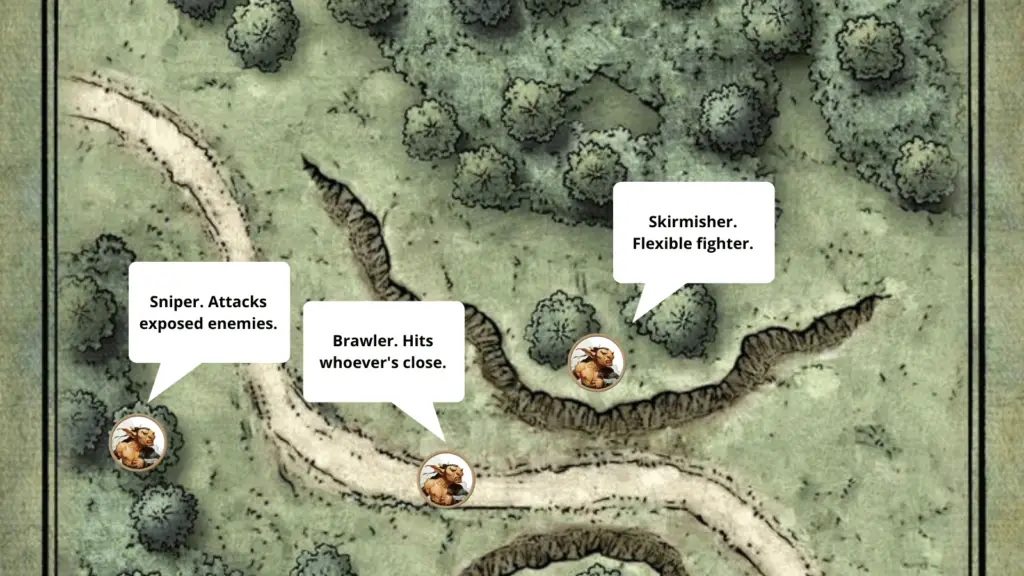
You can make encounters go even faster with a combat “cheat sheet.” If you pre-roll initiative for your monsters, try using a simple combat tracker to keep hit points, tactics, and any other details in order, keeping your turn time as low as possible:

If your players are struggling to make decisions quickly, work with them to make sure they understand each of the features on their character sheet. If decision paralysis is slowing them down, try helping them build a simple combat flowchart:
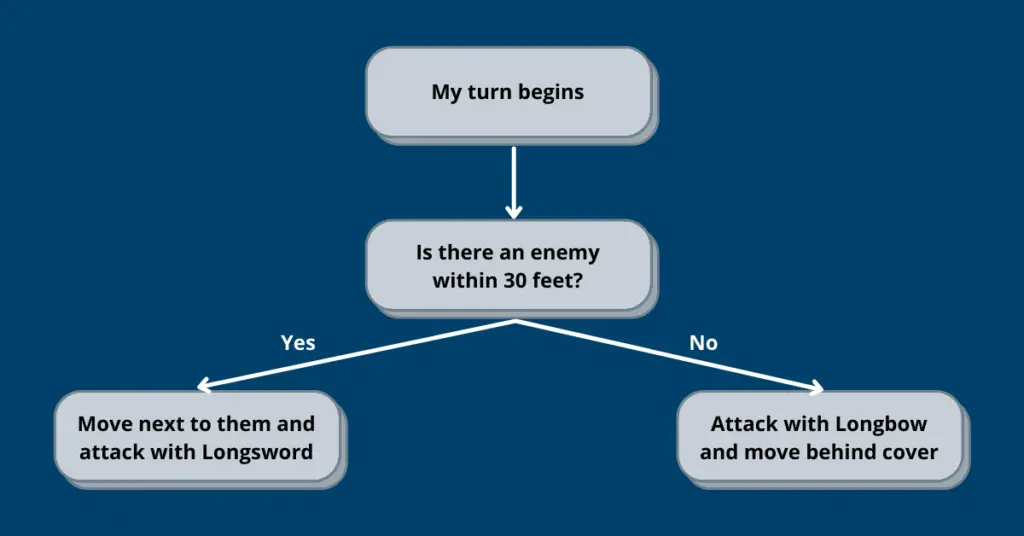
2. Make Enemies Stand Out
One goblin falls, but six more remain. When monsters in combat start to feel interchangeable, D&D’s combat system can feel like more of a grind than ever. If you’re looking to give your encounters a more personal touch—and help give your players something to latch onto when making decisions—try giving your monsters some small distinguishing features of their own.
Give each monster a distinct marking, attribute, or accessory: a scarred left eye, an intricate tattoo, or a bandana around the neck. To make them stand out further—especially if you’re using generic monster tokens on a virtual tabletop platform—associate each monster with a distinct color: a red bandana, a green tattoo, or a pale white scar.
Then, choose an emotion for each monster to display. You can pick randomly from an Emotion Wheel or figure out what works best for the encounter you’re trying to create. If you want to make sure a particular monster leaves an impression, you can even try to give it a distinct archetype as well—such as “swashbuckler,” “thug,” or “scholar.”
Don’t spend too much time on this; if a certain monster is “playful” or “anxious,” let yourself improvise its behavior mid-combat instead of planning too much upfront.
3. Force Players to Pay Attention
Combat is at its slowest when players drift in and out of attention. Though restricting phone use and cutting down on distractions can help, it’s tough to stop players from daydreaming when they’re confident that the next round will play out similarly to the last.
Introducing: the Third-Round Twist.
At the start of the third round of combat (or at the end of the second round), make something happen that shifts the dynamics, stakes, or goals of the combat.
Maybe the bugbear grapples the rogue and begins hauling him away. Maybe an ankheg bursts from the soil, angry at the disturbance above its nest. Maybe the goblin shaman activates a dark artifact to strengthen her allies’ attacks.
It’s important to remember that combat encounters, like all D&D storylines, are driven by dramatic questions. These can be as simple as “Can the PCs defeat the goblin ambush?” or as complex as “Can the PCs stop Archon the Malevolent from unlocking the Tomb of Horrors?”
By the middle of the second round of combat, you and your players should usually have a pretty good idea of how that question will be answered. It’s good to have a clear dramatic question—but once you know how it will play out, the tension immediately deflates, turning an exciting battle scene into a boresome chore. By introducing a mid-combat “twist,” you can keep your players on their toes, forcing them to stay plugged into the fight as the dramatic question shifts and evolves.
4. Make Every Interaction Feel Important
Players play D&D to feel important—to feel special. Exploration and roleplay can easily let individual PCs shine, but a lengthy combat encounter can make even epic turns struggle to stand out.
Play-by-play descriptions are the obvious antidote. As one player finishes their turn, take a few moments to describe what it looked like, especially if you can do so in a way that sets up the next player’s turn:
| Boromir—you duck, weaving through the orc’s defenses, then pivot to drive a deep slash across its left side. The orc roars and stumbles back, doubling over in pain. Pippin—you see an opening to strike. What will you do? |
(If you’re having trouble finding the words to describe what combat looks like—especially for magical effects—try using a damage-description cheat sheet).
It’s important, also, to remember that players and monsters are generally meant to be competent fighters. While it’s occasionally funny for a goblin to slip on a banana peel, players feel happiest when they can feel like skilled warriors. When a PC hits with an attack, focus on the power of their blow, the flourish of their spell, or the cunning of their tactics. Make clear that no ordinary adventurer could have bloodied this beast.
Conversely, even when your players miss their attacks (or the monsters succeed on their saving throws), it’s important to avoid making players feel as though they’ve just wasted their turn—or, worse, embarrassed themselves. Remind your players that their foes are worthy opponents, describing the toughness of their hides, the swiftness of their movements, or the resilience of their will.
You can even hint that the player’s effort has somehow thrown the monster off-balance or opened an opportunity for another PC to attack. Attacks do not take place in a vacuum, after all. Even a strike that fails to deal damage can still be woven into the tapestry of a fight.
5. Keep the Scene Vivid
In the midst of dice rolls, tough decisions, and token-tracking, it’s easy for players to miss the forest for the trees, losing themselves to tunnel vision and forgetting the stakes or scene of the fight.
To keep your players grounded, keep the scene vivid, providing regular context as the turns go by. Once or twice per round, as you move from one player’s turn to the next, briefly remind the upcoming PC of the stakes they’re facing: the enemies around them, the nearby fights, and the overarching goals of the encounter:
| Pippin, you’re up! As you dodge the orc’s last slash, breathing hard, you see that Boromir is struggling beneath an onslaught of orcs nearby. You can hear Legolas’s cries in the distance—he’s slowly getting closer. The orc in front of you looks weak, but Boromir looks weaker. What will you do? |
At the start of each round, you can also take a few moments to place the entire encounter in context, roughly describing each combatant’s health, the appearance of the scenery, and the evolution of the encounter’s central dramatic question.
You can also go even further, personalizing the scenery and stakes through quips and other dialogue offered by your monsters. (Choosing distinct monster personalities—see Rule #2—can make this even easier).
| Pippin—the orc before you grins, yellowed teeth poking from beneath its lip. “Can’t save your friend,” it grunts. “More meat for the cookpots!” What will you do? |
It might feel like all of this extra narration will make combat take even longer—but, strangely enough, when players feel fully engaged in the story that combat tells, their decisions tend to come quicker and more decisively.
After all, it’s easy to get caught in optimization quicksand when the orc in front of you is nothing more than numbers on a page. Acting naturally comes more easily when that orc feels like a real, flesh-and-blood enemy.
6. Help Players Stay Accountable
Most players want combat to be quick—but it can be tough for them to do so, especially if they’re new. To help them, make sure they can always see the initiative order during combat, so that they know exactly when it’s safe to “tune out” and exactly when they need to start tuning back in.
To let players know to start preparing their turns, you can also announce “on-deck” initiative whenever you move to a new creature’s turn. With your players’ permission, you can even use an informal turn timer, giving players a limited amount of time (e.g., 10 to 20 seconds) to start making a decision before they’re automatically forced to take the “Dodge” action.
If you do set up a turn timer, however, make sure to remember: As the DM, you’re your players’ cheerleader, not their boss or parent. Especially when running for players with social anxiety or other mental challenges, it’s important to be empathetic and patient. Instead of using warnings or threats, use your words and tone of voice to give them a sense of urgent encouragement:
| Pippin—what’s it going to be? That orc is already rearing back for a second strike, and Boromir’s not going to be up much longer without your help! Time is running out—what will you do? |
7. Minimize Interruptions
If you’re trying to manage combat with the elegance of a dolphin breaching the waves, nothing can trip you up as much as an ill-timed visit to the Monster Manual or Player’s Handbook. Even if a rules detour takes no more than thirty seconds, the narrative thread is lost, forcing you to jumpstart the tension again instead of picking up where you left off.
Do as much as you can to keep all of the materials that you and your players might need within arm’s reach. Spell cards can be a handy tool here. If you own the monster’s statblock on D&DBeyond (or if its stats are included in the free SRD), you can take a screenshot and print the statblock for easy reference.
Using a streamlined combat tracker (see Rule #1) can make your life even easier. Similarly, a simple “combat sheet” that omits non-essential features and abilities can help keep your players’ turns short and sweet:
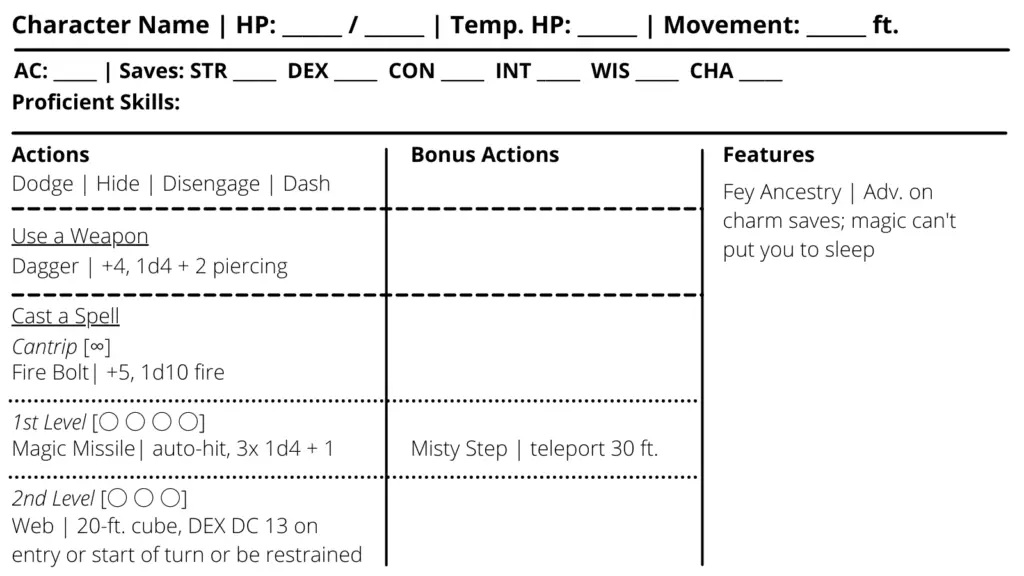
When it comes to looking up rules, remember that 5e is a game about rulings, not rules. Apply the rule as best you can without looking it up, and let your players look up the actual rule after their turn ends so that you can get it right the next time around.
8. Create an Immersive Experience
Though 5e is, by nature, a combat-focused game, its combat encounters can ironically feel far removed from D&D’s “narrative” experience. Combat—with its modifiers, damage rolls, rule-checking, and dice-searching—can destroy verisimilitude in an instant, reminding your players that they’re just a bunch of people sitting around a table, rather than the Fellowship of the Ring on a quest to save Middle-Earth.
Do all you can to keep your encounters an immersive experience. Use battle music to set the mood, banishing awkward silences and amping up your players’ adrenaline. If you’re able, use pre-prepared miniatures, tokens, or battlemaps; if not, tasteful artwork can work wonders to set the scene.
After all, D&D’s combat isn’t just another mini-game. It is—and should feel like—a cornerstone of the campaign’s world. Make sure your players remember that.
About the Author: DragnaCarta is a guest writer for FlutesLoot.com and a veteran DM with 12+ years of experience. He is the author of the popular “Curse of Strahd: Reloaded” campaign guide and the Dungeon Master and director for the Curse of Strahd livestream “Twice Bitten.” You can get his personal RPG mentoring plus early access to projects by joining his Patreon.
Cast Message in the comments section below to ask DragnaCarta about this topic. You can find other articles by DragnaCarta on FlutesLoot.com.

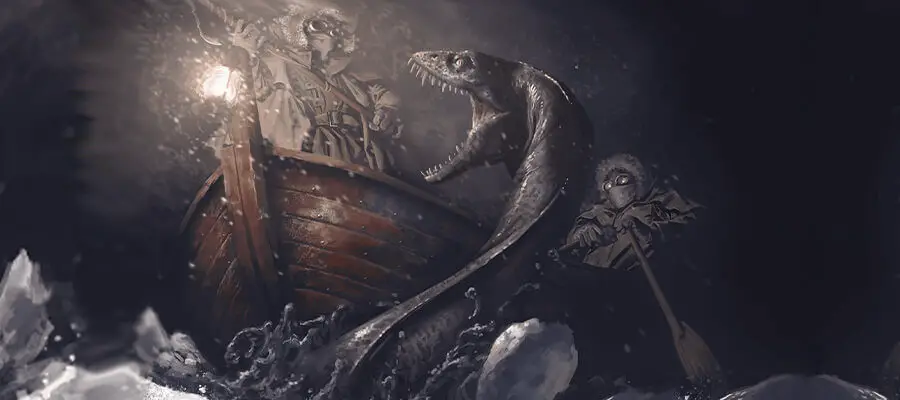


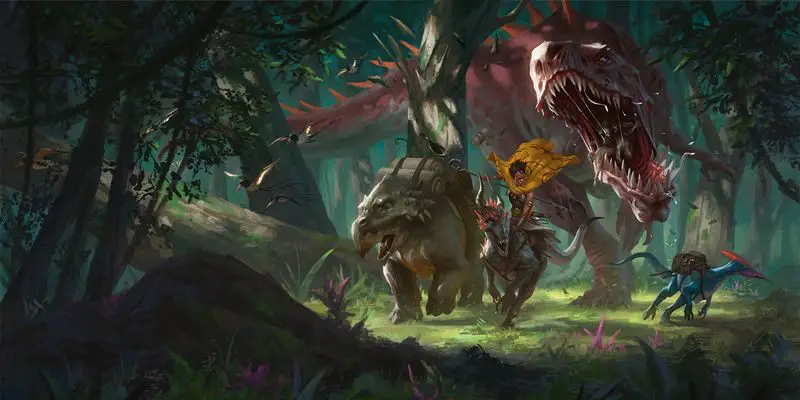
Love the Third Round Twist!
Added to the Blog Database.